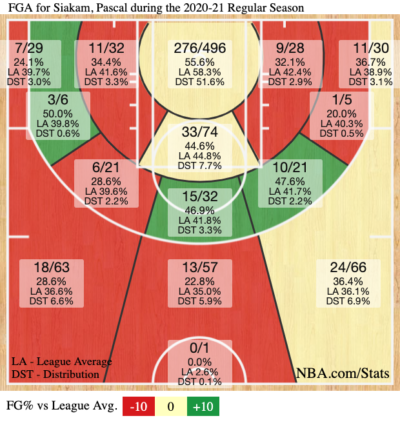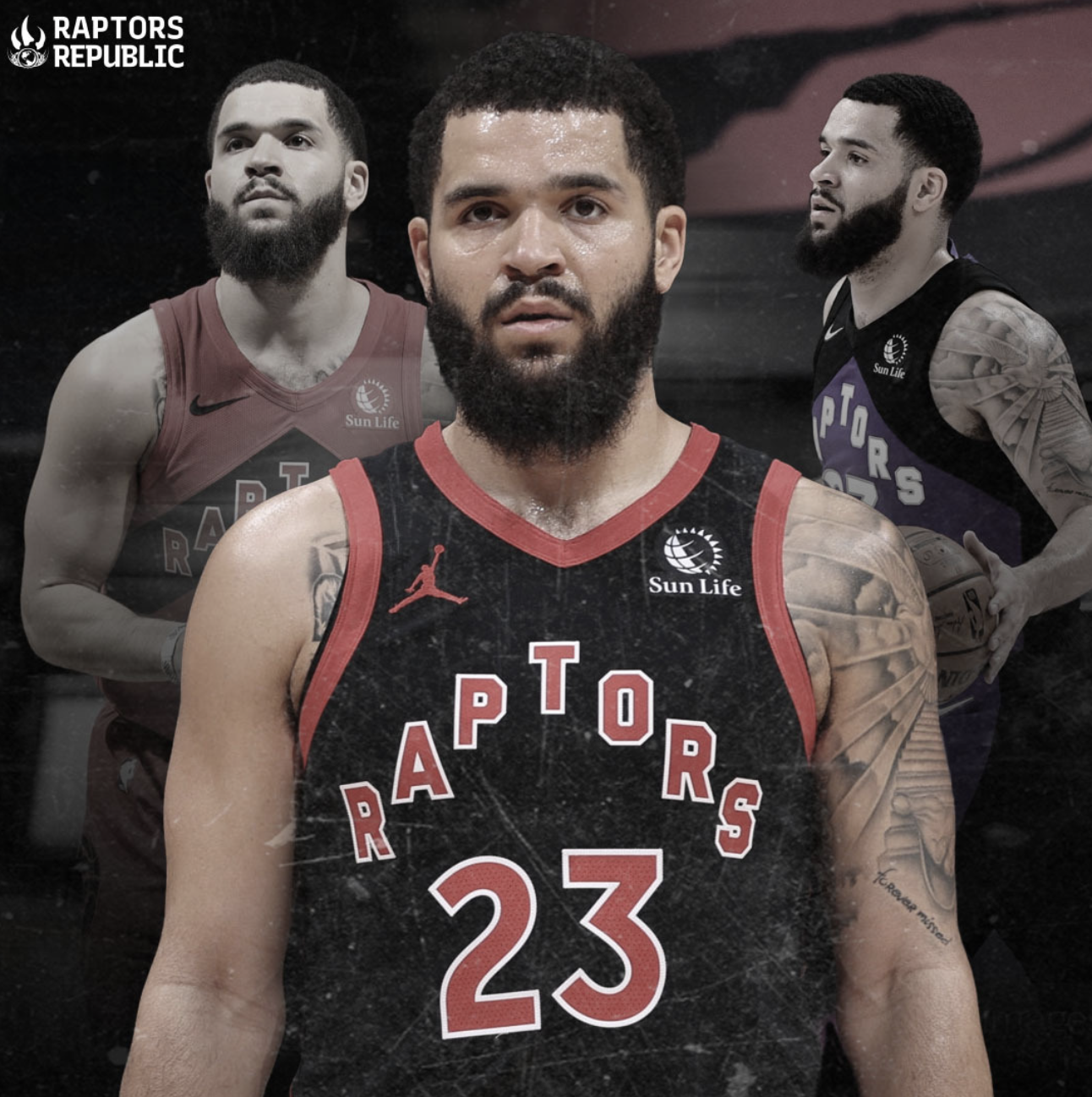This is part of a series of player review from the 2020-21 season. To find the remainder of the series, please click here.
In my review of Pascal Siakam for the 2019-20 season last October, I wrote that “judging Pascal Siakam based solely on his play in the bubble would be unfair and unwise.”
Like many others, I expected Siakam’s bubble play to be a blip in an otherwise All-NBA season; a rough patch in an NBA career that had otherwise consistently trended upwards. Since Siakam’s rookie season, he has gotten better and better despite his advanced age, winning the NBA’s Most Improved Player Award in 2018-19 and All-NBA Second-Team in 2019-20, so it was reasonable to assume that his subpar play in the bubble was more related to his taking time away from basketball during a global pandemic than it was his inability to overcome defences who learned his habits and schemed for him as the No. 1 option.
After the 2020-21 season, I have to admit that my optimism has waned in that regard. I am no longer confident that Siakam can be the “No. 1 option” many of us thought he would develop into — the kind of guy who you can give the ball to and say: “go get a bucket” — but that doesn’t mean he isn’t good, it doesn’t mean the Raptors should look to trade him, and it doesn’t mean that his contract is going to hurt them, because Siakam is a really useful and versatile player who is perfect for the modern NBA, and he showed real signs of growth in 2020-21.
CJ McCollum, Tobias Harris, Andrew Wiggins, Kevin Love, Blake Griffin, Kemba Walker, John Wall, Russell Westbrook, and Tingis Pingis all made more money than Siakam this year.
He has no injury concerns, is improving, and is borderline All-NBA.
everything is chill as hell
— Samson Folk (the coach) (@samfolkk) June 2, 2021
While Siakam’s scoring (21.4 points per game) and true shooting (54.7 percent) did both decrease slightly from the prior season — mostly due to a dramatic drop-off in three-point volume (4.4 per game) and percentage (29.7) — Siakam rounded out his game in ways that should bode well for his and the Raptors’ future.
Let’s start on offence.
Siakam improved his ball-handling and balance this season, getting to his spots more consistently and rising up with better balance than we had seen from him in the past. It’s no wonder he shot an improved 41 percent from the mid-range, with 39 percent of his shots coming from there. Oddly, his rim-frequency and percentage were both slightly down from last season, but a lot of that had to do with poor spacing (Aron Baynes) and subpar finishing from Siakam, as he often got to the rim on balance but struggled to finish through contact or with speed.
The real issue was his three-point shooting. It’s the reason Siakam had the lowest true-shooting percentage since his rookie season and it’s also why he took so many more mid-range shots than we are used to seeing. Siakam’s three-point shot simply wasn’t there to start the season, and he lost confidence taking it for long stretches. However, he did start to shoot much better towards the end of the season and, considering that he shot better than 35 percent in each of the prior two seasons, I believe that his shot is due for some positive regression.

If you have heard people remark that Siakam actually had a better 2020-21 than he did in 2019-20, they most likely cite his improved playmaking as the primary reason. In fact, the Raptors were +9.1 points per 100 possessions better with Siakam on the floor than off of it this season, better than his mark of +7.7 last season. But i’m still not ready to go that far, because Siakam’s 2020-21 season was so inconsistent (due in part to him getting COVID) that I would rather have a slightly worse player who you know what you are going to get out of on a consistent basis than one who has higher highs but lower lows, but who you don’t really know what you are going to get out of on any given night, which is how I would describe Siakam’s 2020-21 season.
With that being said, Siakam’s highs were significant, because taking the step from star to superstar requires you get your teammates involved and learn how to prop up those around you. It also means reading the floor at an advanced level and understanding when to pass and when to score. On Siakam’s best nights, he did exactly that.
Siakam averaged a career-high 4.5 assists per game with 2.5 turnovers, and a career-high assist percentage of 20.5 with a career-low turnover percentage of 10.6. As the season went along, Siakam improved as a passer not just out of the post with his back to the basket, but also in the pick-and-roll and in transition, where it is imperative that he continues to make better decisions with the ball if the Raptors want to get back to their elite ways on the run. Overall, Siakam’s playmaking and game-management was really impressive this season, as we saw real growth in his decision making and ability to read the defence, often outplaying stars on the other side. Plus, most of it came with a non-floor spacing center on the court beside him. If the Raptors can use this offseason to add a floor-spacing, rim-running center alongside Khem Birch, Siakam should see those numbers rise even further, and his scoring should also be easier to come by.
Defence is where most people massively underrate Siakam. Here’s the thing: watch the ongoing playoffs and you will see how many teams are playing small without a traditional center right now. The Denver Nuggets do it when Nikola Jokic is sitting, as do the Portland Trail Blazers when Jusuf Nurkic is out. The Los Angeles Clippers have gone all-in on it, as have the Brooklyn Nets. It’s somewhat of a fad right now to play small, fast, and spaced-out in the NBA, even if you don’t necessarily have the personnel to do so.
The Raptors do have the personnel, and with apologies to OG Anunoby, nobody matters more to their ability to successfully play small-ball than Siakam. That’s not to say Siakam is the best defender on the team or even the most versatile (hi OG), but it’s his unique skill set, long wingspan, and fast closeouts that allows the Raptors to play small, seamlessly going from protecting the rim to closing out on the perimeter, rotating, and doing it all over again within the same defensive possession. Anunoby is usually tasked with guarding the best perimeter player on the opposing team, and in turn Siakam is often used more as a help-defender, rotating all over the court and bailing out his teammates by contesting shots, even if his block rate hasn’t increased (if Siakam ever gets his timing down on blocks… watch out, because he is always right there).
Of course, the Raptors were not a very good defensive team this season, and Siakam was often caught losing his man on back-door cuts or lobs. But i’m not too worried about that because a lot of it was due to Siakam adapting to a different role on defence and being asked to do more, and we saw what Siakam can do defensively when locked into a playoff series like he did against the Boston Celtics last postseason. What is important long-term is that Siakam’s defensive versatility payed off during the stretch where the Raptors were healthy in February and starting the small-ball lineup with Powell at the three, when Siakam was masterful as the small-ball five in wins against the Milwaukee Bucks and Philadelphia 76ers.
Siakam’s season — and the Raptors disappointing season as a whole — comes down to a faulty supporting cast more than a lack of star power. The Raptors surrounded their core with players who were too raw and/or never fit the system, and consequently they had to play small a lot, pushing players like Siakam to learn new habits on the fly. They played well in those minutes, with the small lineup going +14.0 per 100 possessions on the season, which should bode well for the future, as the Raptors will always have those small lineups in their back pocket.
At the end of last season, I wrote: “let’s judge Siakam by his response to experiencing adversity for the first time in his NBA career.” While this might sound like somewhat of a cop out, his response to adversity was met with more adversity. The Raptors had to play in Tampa Bay and deal with COVID and injuries throughout the season, so it’s not exactly like we had a clean slate to evaluate him on.
With that being said, Siakam’s playmaking took real strides this season and he proved that he could be a centrepiece in small-ball lineups that were successful on both sides of the floor. That’s important, now more than ever given the state of the NBA. On the downside, he struggled to finish in all areas of the court, and that is an area for concern, especially if he is going to be a No. 1 option.
However, when I say Siakam might never become the No. 1 option we hoped he would, that doesn’t mean that he can’t be efficient while carrying the highest usage on a good team — I think he can do that with just a little bit more consistency. Rather, it means that I would be surprised if Siakam develops into the type of player who you can consistently ask to create efficient offence in isolation situations when the game bogs down to a halt.
That’s fine. Very few NBA players are capable of doing that efficiently. Look at Giannis Antetokounmpo, who was miscast as that type of player for years and has recently looked much better as a secondary option on offence who can dominate defensively and carry his team against certain matchups on offence (watch out Brooklyn). Siakam has always reminded me a little bit of Antetokounmpo, but partly because he isn’t as athletic or as large, that three-point shot is incredibly important for Siakam.
In fact, Siakam’s offence really comes down to this: can he figure out a few plays where he can butter his bread, consistently getting his shot off comfortably and confidently. Right now, the post-up is his most reliable offensive weapon, and his transition offence should always be good, too. But outside of that, Siakam needs to find a couple places on the floor where he feels comfortable shooting from, or a couple pick-and-roll partners/schemes that he feels comfortable executing with the ball in his hands, because he is so versatile that it sometimes feels like he is okay at everything but not great at anything offensively.
That’s a good problem to have. Versatility is the name of the game in the NBA playoffs, and the Raptors have developed him with that in mind. But the time has come for Siakam focus in on a couple areas of his offence in which he can consistently create efficient shots. Because I still believe in Pascal Siakam, and you should too.



